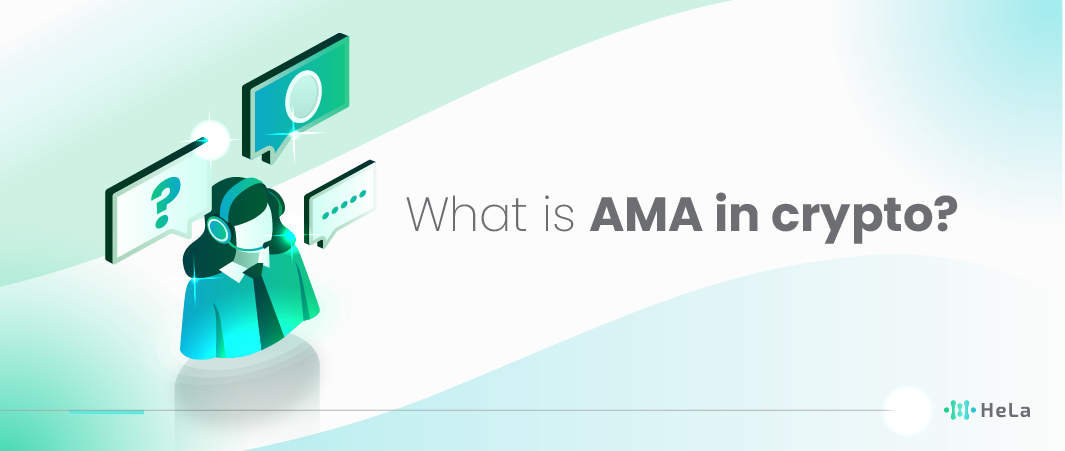In the rapidly evolving world of cryptocurrency, staying informed and connected is key to understanding new projects and opportunities. One method that has gained significant popularity for fostering transparency and community engagement is the AMA, which stands for “Ask Me Anything.” AMA provide a platform where crypto project teams, influencers, and developers open themselves up to questions from their community, offering real-time insights and direct answers.
But why are these sessions so important, and how do they fit into the broader crypto landscape? This article explores the ins and outs of AMA in the crypto world, detailing their origins, significance, and best practices for participants and hosts alike. Whether you are a seasoned crypto enthusiast or just starting out, understanding AMA can give you a clearer perspective on the projects and personalities shaping the future of blockchain technology.
What is AMA in Crypto?

In the crypto space, new terms and concepts emerge almost daily, some of which can be confusing for newcomers. One term that you may frequently hear is “AMA.” But what exactly does AMA mean, and why is it so significant in the world of cryptocurrency?
Read More: 12 Best Crypto Presale to Check This 2024
AMA stands for “Ask Me Anything.” It is a type of interactive event where project teams, developers, or key figures in the crypto industry invite the community to ask them questions about their project, services, or the state of the crypto market. These sessions can take place on social media platforms, such as Reddit, Twitter, Telegram, or other community-driven platforms, and they serve as a way to build transparency and trust between a crypto project and its community.
History of AMA in Crypto

The concept of AMA originated from the broader tech community, where developers and project leaders would hold open Q&A sessions to interact directly with users. In the early days of platforms like Reddit, these AMA sessions became a way for influencers, politicians, or even celebrities to communicate with their audience in a raw, unfiltered manner.
As cryptocurrency and blockchain technology grew, the crypto community began adopting the AMA format. Blockchain is decentralized by nature, and communication between project teams and their communities is essential. The AMA format allows transparency, which is vital in the world of crypto, where trust issues and scam projects are prevalent.
Why Do AMAs Matter in Crypto?
Crypto projects rely heavily on community engagement for growth and development. AMAs give users a platform to interact with the people behind the projects and ask pertinent questions. This interaction helps community members learn more about the technical details of a project, its roadmap, and its team’s vision for the future. But AMAs offer more than just information; they offer an opportunity for investors and potential users to gauge the trustworthiness of a project.
For instance, during an AMA, a team may explain complicated features such as consensus mechanisms, tokenomics, or governance models. They can also address concerns related to security, decentralization, or partnerships. This transparency can lead to stronger relationships between the team and the community, which can ultimately increase the project’s credibility and market appeal.
How an AMA Works
An AMA typically begins with an announcement from the project’s team or the host platform. The team will set a date and time for the AMA and provide instructions on how to participate.
Here is a typical flow of events:
- Pre-Event Announcement: The team will inform the community in advance, usually through their social media accounts, Telegram groups, or forums like Reddit. This pre-announcement may include details such as who will be answering the questions, the format of the session, and how users can submit their questions.
- Submission of Questions: Before or during the AMA, participants will submit their questions. Depending on the platform, participants might ask questions through live chat, submit them on social media using a specific hashtag, or post them on forums.
- Answer Session: The project’s team or guest will review the questions and answer them in real-time. Depending on the nature of the AMA, the answers may be typed out in a chat window or delivered via video or audio.
- Closing Remarks: After answering the most important or popular questions, the team may provide closing remarks and a brief summary of the event. This might also include a final call-to-action, such as an invitation to join their social media platforms or participate in a token sale.
Types of AMA in Crypto

AMAs in the crypto space can take on different formats, each tailored to the needs of the project team, community, or platform hosting the session. Depending on the objectives—whether educating users, building community trust, or unveiling new features—AMAs can vary significantly. Let’s dive deeper into some of the most common types of AMAs you might encounter in the cryptocurrency world:
1. Text-Based AMA
Text-based AMAs are perhaps the most common format, particularly on platforms like Reddit, Telegram, and Twitter. These AMAs involve users typing their questions, which are then answered by the project’s team or special guest in written form.
- Reddit: Reddit’s “r/cryptocurrency” or “r/bitcoin” are popular destinations for text-based AMAs. Project developers, influencers, and even exchange founders often hold sessions in these subreddits. The platform allows for long, detailed responses, and each question is answered in a threaded format, making it easier for participants to follow the conversation.
- Telegram: Many crypto projects have dedicated Telegram groups where text-based AMAs take place. These sessions usually occur in real-time, with project members answering a selection of pre-submitted or live questions. Telegram is particularly popular because of its massive user base in the crypto community, allowing projects to engage with a broad audience.
- Twitter: Twitter is another popular venue for text-based AMAs, especially with the use of hashtags and Twitter threads. Teams might ask followers to submit questions using a hashtag like #ProjectXAMA. The answers are then provided in a series of tweets, making the AMA highly shareable and open to wider engagement.
2. Live Video AMA
Live video AMAs offer a more interactive and personal experience. Projects typically host these sessions on platforms such as YouTube, Zoom, or Facebook Live, allowing users to see the project’s team in real time. This format provides more transparency as viewers can assess the authenticity of responses through body language, tone of voice, and facial expressions.
- YouTube: Many crypto projects use YouTube to host live AMAs, as it allows the session to be streamed live while also being recorded for future viewing. Some YouTube AMA sessions have thousands of viewers and feature a combination of pre-submitted questions and live Q&A via the comment section.
- Zoom: For smaller, more intimate AMAs, projects sometimes opt for Zoom sessions. This format allows participants to engage more closely with the project team, and it also offers the possibility for two-way communication—participants can ask questions via audio rather than text.
- Facebook Live: Although not as popular as YouTube for crypto AMAs, Facebook Live offers an alternative venue, especially for projects that have large communities on the platform. Facebook Live has integrated features like live commenting and reactions, making the interaction dynamic.
3. Audio AMA
With the rise of platforms like Clubhouse and Twitter Spaces, audio AMAs have become an increasingly popular choice in the crypto world. Audio-only sessions offer a more relaxed, conversational feel where project leaders can communicate openly with their audience without the pressure of being on camera. These platforms create an atmosphere similar to a live radio show, where participants can listen in and even be invited to speak or ask questions.
- Clubhouse: A growing number of crypto projects have used Clubhouse for their AMAs, especially during the app’s early 2021 boom. Clubhouse AMAs feel casual yet informative, and anyone in the “room” can ask to speak or raise their hand to participate.
- Twitter Spaces: Similar to Clubhouse, Twitter Spaces provides an audio-only platform for hosting AMAs. It integrates directly with Twitter, allowing projects to leverage their existing follower base. Participants can ask questions live by speaking in the space, while others can simply listen in.
4. AMA with Incentives
To encourage participation and make the AMA session more engaging, many crypto projects offer incentives such as token giveaways, NFTs, or other rewards to users who ask insightful questions. These incentive-based AMAs not only draw a larger crowd but also encourage more meaningful discussions.
- Giveaway AMAs: Some projects promise token giveaways or airdrops to users who participate in the AMA. In these sessions, projects may reward the best or most thoughtful questions with tokens, boosting the event’s visibility and encouraging engagement.
- NFT Prizes: In the rapidly growing world of NFTs, some projects use these unique digital assets as incentives for participation. Users might receive an exclusive NFT for participating or even have their question immortalized as an NFT in exchange for their contribution.
5. Pre-Recorded AMA
Sometimes a project team may opt to conduct a pre-recorded AMA. This means the team gathers questions ahead of time, records the answers offline, and then releases the session as a video or text transcript at a later time. This format can be ideal for addressing highly technical questions that require more thought or for managing time zone differences with global communities.
- YouTube/Telegram/Reddit: The team may solicit questions from the community in advance on platforms like Telegram or Reddit and then produce a video or write-up answering those questions.
6. Hybrid AMA
A hybrid AMA combines elements of different formats, such as using both text and video or hosting a live session with some pre-recorded segments. Hybrid AMAs are flexible and can cater to various audience preferences, making them versatile in reaching both casual and deeply engaged users.
- Live Video with Text Questions: A project might hold a live video AMA while taking questions from Twitter or Reddit in real time. This can increase participation by allowing those who are uncomfortable with speaking on camera to still engage.
- Recorded Follow-Up: Some teams host a live AMA but follow up with a recorded Q&A to address questions they couldn’t get to during the live session.
Crypto AMA Best Practices
While participating in an AMA can be exciting, it’s essential to approach it the right way, whether you’re a project leader hosting one or a participant asking questions. Here are a few best practices to consider:
For Project Teams
- Be Transparent: The community values honesty. If your project is facing challenges, don’t be afraid to address them. Being forthright builds trust.
- Prepare Key Talking Points: Have a clear agenda for the AMA. You can structure your answers by addressing major areas such as technology, partnerships, and future plans.
- Engage with the Audience: Make the session interactive by addressing community members by name and expressing gratitude for their questions. Showing appreciation for their engagement will foster goodwill.
- Follow Up: After the AMA, post a summary of the event on your social media platforms. This will ensure that community members who couldn’t attend still have access to the valuable insights shared.
For Participants
- Do Your Research: Before the AMA, take the time to research the project and its key figures. You’ll get more value out of the AMA if you ask insightful, well-thought-out questions.
- Be Respectful: Remember that the project team is taking time out of their day to answer your questions. Be polite and avoid trolling or making irrelevant comments.
- Ask Clear Questions: Ensure that your questions are easy to understand. Ambiguous or poorly worded questions are less likely to be answered.
- Take Notes: During the AMA, write down key points and answers to any questions that matter to you. This will help you retain the information and act on it later.
Notable AMAs in Crypto History
Over the years, several significant AMAs have captured the attention of the crypto community. Below are a few notable ones:
- Vitalik Buterin (Ethereum): Vitalik has conducted several AMAs over the years, where he has discussed Ethereum’s vision, technology upgrades, and scaling solutions. These AMAs often focus on Ethereum’s development milestones and its future roadmap.
- Changpeng Zhao (Binance): The CEO of Binance, one of the largest cryptocurrency exchanges globally, often hosts AMAs to interact with Binance users, address concerns about the platform, and announce upcoming features. These sessions provide a unique window into the inner workings of Binance and its direction.
- Elon Musk’s Dogecoin AMA: When Elon Musk casually held an AMA related to Dogecoin, it created an enormous buzz in the crypto space. His comments on Twitter and during AMAs have even been known to impact the market price of DOGE.
Read Next: Top 10 Blue Chip Cryptocurrencies to Consider in 2024 (Updated List)
Benefits of AMAs in Crypto
AMAs hold significant value for both project teams and participants in the crypto space. Below are a few key benefits:
For Projects
- Direct Engagement: AMAs allow projects to engage with their community directly. This fosters a sense of connection and allows the team to address concerns, dispel rumors, or provide clarity on confusing topics.
- Builds Trust: When a team is willing to answer questions publicly, it shows they are confident in their project. This level of transparency can attract investors and community support.
- Feedback Loop: AMAs are an opportunity for projects to gather feedback from their community. Questions about pain points or features can give the team insights into areas they need to improve.
For Participants
- Informed Decision-Making: AMAs give potential investors and users a chance to ask detailed questions about the project. This helps them make more informed decisions about investing or using the platform.
- Access to Insider Knowledge: AMAs often reveal details that aren’t publicly available in other forums, such as updates on upcoming features or partnerships.
- Personal Connection: Participants in AMAs feel more connected to the project team. This personal connection can build loyalty and increase participation within the community.
Conclusion
Ask Me Anything (AMA) sessions have become a vital part of the crypto ecosystem. They foster transparency, encourage direct engagement, and provide valuable insights into the inner workings of a project. For project teams, they serve as a platform to gain the trust of their community. For participants, AMAs offer an opportunity to make informed decisions, learn insider information, and build personal connections with the projects they support.
As crypto continues to evolve, the importance of communication between project teams and their communities cannot be overstated. AMAs are here to stay, and they will likely remain one of the most effective ways to bridge the gap between crypto developers and users. Whether you are a project leader or a curious participant, understanding and utilizing AMAs can provide you with valuable insights and opportunities in the crypto world.
Disclaimer: The information provided by HeLa Labs in this article is intended for general informational purposes and does not reflect the company’s opinion. It is not intended as investment advice or recommendations. Readers are strongly advised to conduct their own thorough research and consult with a qualified financial advisor before making any financial decisions.

I am Carina Caringal, a technical writer specializing in blockchain engineering concepts, decentralized systems, crypto infrastructure, and Web3 technologies. My work focuses on analyzing and translating complex technical mechanisms into precise, structured, and insightful content for both developers and non-technical readers who want a deeper understanding of the decentralized ecosystem.
My background in blockchain and cryptocurrency is rooted in years of independent research, continuous learning, and hands-on exploration across multiple protocols and network architectures. I study the underlying mechanics of distributed ledger technology, from consensus algorithms and smart contract logic to network scalability, security models, cryptographic principles, and interoperability frameworks. This technical foundation shapes the way I approach every article, ensuring accuracy, depth, and relevance.
- Carina Caringalhttps://helalabs.com/blog/author/carina-caringal/
- Carina Caringalhttps://helalabs.com/blog/author/carina-caringal/
- Carina Caringalhttps://helalabs.com/blog/author/carina-caringal/
- Carina Caringalhttps://helalabs.com/blog/author/carina-caringal/

